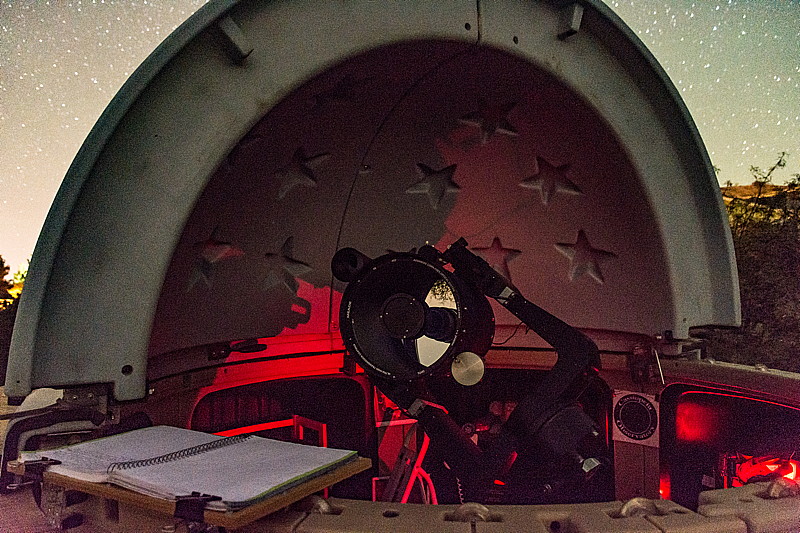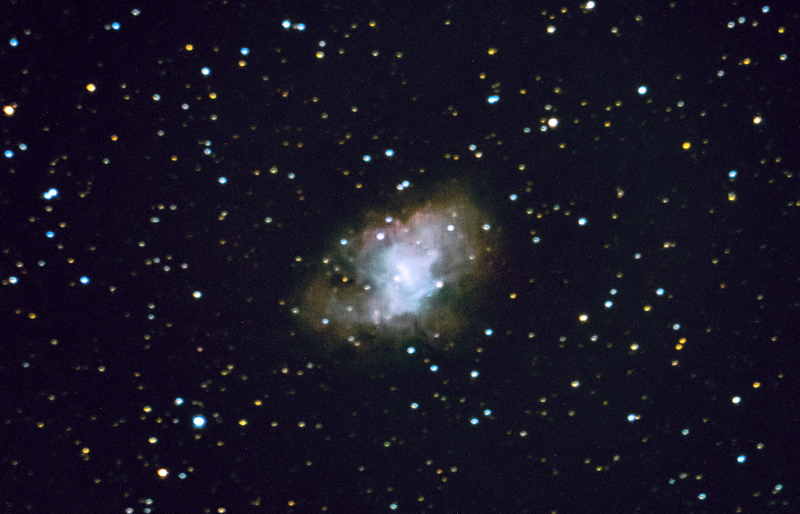Imaging: Crescent Moon, Tiangong-2 Space Station,
Saturn & Mars on Dome, DSOs
Posted: 2 November 2016
Clouds returned on Sunday, 30 October 2016, but the sky cleared on Tuesday, 1 November.
|
Open: Tuesday, 1 November 2016, 1759 MST Temperature: 80°F |
Session: 1033 Conditions: Mostly clear |
Equipment Used:
12" f/8 LX600 w/StarLock
Wireless AutoStar II handset
2" 24mm UWA eyepiece
2" 30mm eyepiece
Camera:
iPhone 6s Plus
D7200 DSLR
1804 MST: LX600 ON, StarLock OFF, High Precision OFF.
1806 MST: viewed the Crescent Moon, 102X and 81X.
Quickly began setting up to image the Moon using the iPhone 6s Plus with the new Levenhuk Smartphone Adapter.
1812 MST: took these afocal 81X photos of the Moon and Earthshine using the Camera app and the earbuds/mic volume control as a remote shutter release:


I then stepped outside of the observatory and mounted the D7200 DSLR on a tripod for this f/4, 1/2sec, ISO 1600, photo of Venus, Saturn, and the Crescent Moon with Earthshine at 1819 MST:

Mouseover or tap on image for labels
The currently occupied Chinese Space Station Tiangong-2 space station would make a nice pass 1831-1837 MST. So I quickly set up to image it using the iPhone 6s Plus, clip-on fisheye lens, Levenhuk adapter on a tripod, and NightCap Pro (ISS mode). This is the resulting image showing the space station (moving upward) along with a plane (top), and Venus, Saturn, and Moon (bottom right):

1843 MST: did some brief lunar observing, 81X. Then viewed Saturn and its moon Titan, 102X.
Mounted the DSLR on the tripod for an attempt to photograph the planet Saturn projected on the observatory dome. I had recently photographed Venus on the dome so I wanted to see if I could capture the fainter Saturn. Unfortunately, as Saturn was low in the sky the conditions were not ideal for this type of imaging. Using 102X I could faintly see Saturn on the dome. This f/3.5, 30 seconds, ISO 1600, photo did capture Saturn, but you will probably need to mouseover or tap on the image to see the arrow pointing to the faint planet:

Mouseover or tap on image for label
I then projected the planet Mars on the dome using 271X. It was placed at almost the same location as Saturn for this f/3.5, 30 seconds, ISO 1600, photo:

Mouseover or tap on image for label
After what had been a hectic hour of imaging, I took a short break. When I returned to the observatory I did some telescope visual focus tests.
1942 MST: began doing some sky observing using my old Orion 7x50 binoculars now that I have given up on the Celestron Cometron 12x70 binoculars. Viewed the Double Cluster, M45 (Pleiades), M31 (Andromeda Galaxy) and its companion galaxies M32 and M110, M33 (Triangulum Galaxy), M57 (Ring Nebula), M13 (Great Globular Cluster in Hercules), and did a tour along the Milky Way. I had forgotten how nice these binoculars were.
1952 MST: ended binoculars viewing and returned to the telescope. Viewed NGC6992 (nebula) and then NGC6960 (Veil Nebula), 102X. I added a 2" O-III filter and viewed both nebulae. The views with and without the filter were good, but I actually preferred the view without the filter.
2015 MST: began setting up for Deep Sky Object (DSO) imaging using the 12" LX600 and D7200 DSLR. Mounted the DSLR at prime focus + focal reducer. High Precision ON, StarLock ON for autoguiding while imaging. These are the DSOs I imaged this night:
NGC6992, 5 minutes, ISO 6400, White Balance 4000K

NGC6960 (Veil Nebula), 5 minutes, ISO 6400, White Balance 4000K

NGC6888 (Crescent Nebula), 10 minutes, ISO 5000, White Balance 4000K

Removed the focal reducer and took these DSO images at prime focus:
NGC1300 (galaxy, slightly cropped), 5 minutes, ISO 6400, White Balance 4000K

M1 (Crab Nebula, slightly cropped), 3 minutes, ISO 5000, White Balance 4000K

The M1 image is slightly out-of-focus; I will re-image on a future session.
2321 MST: ended DSO imaging. Removed the camera from telescope.
2330 MST: viewed M1 (Crab Nebula) and then M42 (Great Nebula in Orion), 102X. Both were nice views.
|
Close: Tuesday, 1 November 2016, 2342 MST Temperature: 57°F |
Session Length: 5h 43m Conditions: Mostly clear |
I have posted my review of the Levenhuk Smartphone Adapter. If you want to use a good but inexpensive adapter for smartphone astrophotography, check it out.
I have updated my Celestron Cometron 12x70 Binoculars review.
In the HOPEFULLY GOOD NEWS department is this item on the Arizona Science and Astronomy Expo Twitter profile:

The last one was in November 2014. It was a big success and followed the highly successful ASAE events in 2013 and 2012. Sure hope it does return in 2017.
Comments are welcome using Email. Twitter users can use the button below to tweet this report to your followers. Thanks.
Cassiopeia Observatory Home Page
Copyright ©2016 Michael L. Weasner / mweasner@me.com
URL = http://www.weasner.com/co/Reports/2016/11/02/index.html
